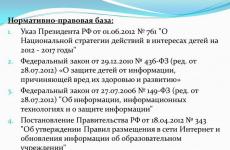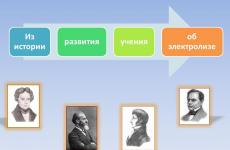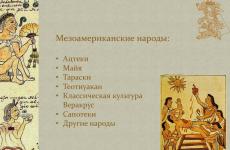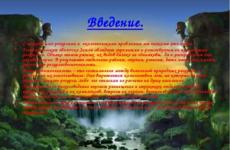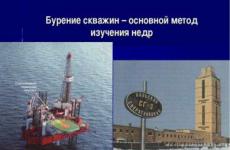From A. Popov to the present day. Presentation on the topic Invention of radio by Popov (grade 11) Popov m preparation of presentation
Description of the presentation by individual slides:
1 slide
Slide description:
2 slide
Slide description:
Alexander Stepanovich Popov (1859 - 1906) - physicist, electrical engineer, inventor, known as the Russian creator of radio.
3 slide
Slide description:
Childhood Alexander Stepanovich Popov was born on March 16, 1859 in the Ural village of Turinskie Rudniki, which was located in the then Perm province. His father, Stepan Petrovich Popov, was a local priest. Mother, Anna Stepanovna Popova, took care of the housework. Besides Alexander, there were 6 more children in the family. The family was not wealthy and lived more than modestly. Since childhood, his passion for exact sciences and various mechanisms distinguished Sasha from the rest. The boy was thin, awkward and shy, he couldn’t stand fights and preferred solitude to noisy games, for which he received the nickname “professor”. 1869
4 slide
Slide description:
Parents A.S. Popova - Stepan Petrovich with his wife Anna Stepanovna, Bogoslovsk, ca. 1890. Italian pencil, drawing by A.S. Popova-Kapustina. Published for the first time. Stepan Petrovich Popov - father of A.S. Popova Parents
5 slide
Slide description:
A.S. Popov; his father Archpriest S.P. Popov; mother, Anna Stepanovna; Augusta's sister. In the first row from the left is Sister Capitolina; on the right is niece Anna Vasilievna Slovtsova (married Shadrin).
6 slide
Slide description:
As a child, Popov repaired a clock and built an alarm clock out of it, and not a simple one, but with an adjustable wake-up time. Under the clock-walker, he vertically fixed a metal ruler with several holes, into any of which a conductive pin could be inserted. The walkers were installed so that the cast iron weight at the end of their chain, for example, at six in the morning reached a removable contact in the upper hole of the ruler, and at seven in the morning - in the next lower one, etc. When the plumb line came into contact with the contactor, the electric bell was connected to the galvanic battery through lead wires, a ruler with a pin, a weight and a watch chain. The sounder worked properly. View of the rooms in the house of A.S. Popov’s parents. In the foreground in the upper right corner you can see part of the “electric alarm clock” designed by A.S. Popov in childhood.
7 slide
Slide description:
In 1869, when Alexander was 10 years old, he entered the Dalmatovo Theological School. Here he studied until 1871, and then moved to the Ekaterinburg Theological School. In 1873, Popov entered the Perm Theological Seminary. Four years later, he graduates from general education classes at the seminary and decides to end the spiritual direction in education. In 1877, Alexander became a student at St. Petersburg University, Faculty of Physics and Mathematics. Studying at the university was very difficult for him. The main problem was the lack of money. Popov worked part-time as an electrician, but still had to save on absolutely everything. In 1882, Popov received his diploma and remained at the physics department at the university to prepare for professorship.
8 slide
Slide description:
Family A.S. Popov with his wife and children. 1893 By the end of the university, Alexander Popov got married. In 1884, his first-born Stepan was born, and three years later his second son, Alexander. The wife, Raisa Alekseevna, had a permanent medical practice, and often her income became the only one in their family, since all her husband’s money was spent on experiments.
Slide 9
Slide description:
10 slide
Slide description:
Alexander Stepanovich Popov was one of the first to study the possibility of using electromagnetic radiation in practice. In 1895, he created a device that recorded electromagnetic waves. At that time, Popov was a teacher at the Mine Officer Classes in Kronstadt, where they trained officers involved in electrical engineering on ships. Popov's first radio receiver recorded only lightning discharges. But already on March 12, 1896, Morse signals were transmitted over a distance of 200 m, which were recorded on tape. We can say that this was the world's first wireless communication session, or the first radio transmission. Step by step Popov improved his invention. And already in the spring of 1897, the transmission range of radio signals increased to 640 m. And after some time, a communication session was successfully carried out between warships that were located at a distance of 5 km from each other. INVENTION
11 slide
Slide description:
A sketch of the first receiver for wireless telegraphy developed by A.S. Popov himself.
12 slide
Slide description:
The main invention of A.S. Popov on April 25 (May 7), 1895, at a meeting of the Physics Department of the Russian Physical-Chemical Society at St. Petersburg University A.S. Popov made a sensational scientific report on his invention of a wireless communication system. A. Popov demonstrates his invention
Slide 13
Slide description:
Popov receiver circuit The receiver consists of a coherer of an electromagnetic relay of an electric bell of a direct current source
Slide 14
Slide description:
Many are interested in the question of the priority of A.S. Popov in the invention of radio. In many Western countries, Marconi is considered the inventor of radio, although other candidates are also named: in Germany Hertz is considered the creator of radio, in the USA and a number of Balkan countries Nikola Tesla. The claim about Popov's priority is based on the fact that Popov demonstrated the radio receiver he invented at a meeting of the physics department of the Russian Physical-Chemical Society on April 25, 1895, while Marconi filed an application for the invention on June 2, 1896. Merit
15 slide
Slide description:
In practice, Popov’s invention was first used in the fall of 1899, when the battleship Admiral General Apraksin landed on rocks near the island of Gogland. There was no connection between the ship and the mainland. But a solution was still found. They were able to manage the rescue operations using Popov’s equipment. Masts were installed on the shore. Antennas were hung on them, equipment was installed with the help of which wireless communication with the ship was maintained
16 slide
Slide 2
Childhood and youth
Alexander Stepanovich Popov was born on March 16, 1859 in the Northern Urals, in the mining village of Turinskie Rudniki, in the family of a priest, rector of the Maximov Church Stepan Petrovich Popov and his wife Anna Stepanovna, the middle of seven children.
Slide 3
Alexander received his primary education at the Dalmatovsky (1869-1871) and Yekaterinburg (1871-1873) theological schools. In 1873 Popov entered the Perm Theological Seminary. In these educational institutions, education for children of the clergy was free, which was of significant importance for the large Popov family.
Religious upbringing instilled in Alexander Popov high moral qualities, which were repeatedly noted by people who knew him. Popov graduated from general education classes at the seminary, which provided knowledge equivalent to a classical gymnasium with the right to enter the university, with honors in 1877.
Slide 4
Alexander’s interest in technology was facilitated by the fact that the Popov family’s circle of acquaintances included many engineers, graduates of the St. Petersburg Mining Institute. He visited mines and workshops with interest and tried to make various mechanisms himself. All his life Popov was grateful to his sister Ekaterina’s husband V.P. Slovtsov, a priest like his father, who taught him carpentry, plumbing and turning.
Slide 5
In September 1877, Alexander Popov entered the Faculty of Physics and Mathematics of St. Petersburg University. Alexander Popov received a scholarship only in the first and third years, and solved his financial problems by tutoring.
At the university, Popov spent all his free time in the physics laboratory, doing experiments on electricity. While still a student, he served as an assistant at the physics department. While studying in his 4th year, he entered the service of the Electrical Engineer partnership, where he had to do installation work and operate small power plants.
Slide 6
Scientific activity
In November 1882 A.S. Popov graduated from the university and, after defending his dissertation on the topic “On the principles of dynamoelectric direct current machines” (January 1883), received a candidate’s diploma. His first scientific article based on the dissertation materials was published in the September issue of the magazine “Electricity” for 1883. By decision of the academic council, A. Popov was left at the university to prepare for a professorship.
Slide 7
In 1883, he accepted an offer to take the position of assistant in the Mine Officer Class in Kronstadt, the only educational institution in Russia in which electrical engineering occupied a prominent place and work was carried out on the practical application of electricity (in maritime affairs). Popov worked in the Mine Officer Class for 18 years, combining teaching activities with scientific research. Here he began the study of electromagnetic waves, which culminated in the invention of radio. From 1889 to 1898, in the summer months, free from classes at the IOC, A. S. Popov was in charge of the power plant that served the Nizhny Novgorod Fair. The experience of working at the Nizhny Novgorod power plant gave Popov material for compiling a textbook on electrical machines, published in 1897 by the Maritime Department.
Nizhny Novgorod power plant
Slide 8
By the nature of his official activity, A.S. Popov was closely connected with the navy, and it was in the navy that the birth of a great discovery took place. The historical conditions for the discovery were ripe; several people almost simultaneously walked towards it in different ways in different countries: Popov, Rutherford, Marconi and others. A. S. Popov was the first to achieve success.
In 1889, A. S. Popov read a series of lectures at the meeting of mine officers “The latest research on the relationship between light and electrical phenomena” according to the following program:
- “Conditions for the origin of the oscillatory motion of electricity and the propagation of electrical vibrations in conductors.
- The propagation of electrical vibrations in the air is rays of electric force. Reflection, refraction and polarization of electric rays.
- Actinoelectric phenomena - the action of voltaic arc light on electric charges.”
Slide 9
- The beginning of A. S. Popov’s work in the field of wireless communications dates back to 1889. By the beginning of 1895, Popov created a “lightning detector”, which made it possible to reliably register the approach of a thunderstorm at a distance of up to
- 30 km. On March 12 (24), 1896, at a meeting of the physics department of the Russian Physicochemical Society, Popov, using his instruments, clearly demonstrated the transmission of signals over a distance
- 250 m, transmitting the world's first two-word radiogram "Heinrich Hertz".
- In the spring of 1895, A. S. Popov and his assistant P. N. Rybkin conducted experiments on transmitting and receiving signals over a distance of 30 fathoms (64 meters) in the IOC garden. A wire raised by balloons to a height of 2.5 meters was used as the receiver antenna.
Slide 10
As a physicist A.S. Popov was interested in scientific discoveries in all areas of the application of electricity. His work in the field of newly discovered x-rays dates back to the beginning of 1896. Already in February, he manufactured one of the first X-ray machines in Russia, and obtained images of various objects, including an image of a person’s hand. With his support, an X-ray room was equipped at the Kronstadt naval hospital in 1897, and subsequently some warships were equipped with X-ray machines.
One of the first X-ray machines.
Two x-rays:
- modern photograph of a human head in color using a computer
- and one of the first X-ray images of a woman's hand.
Slide 11
At the beginning of 1897, Popov established radio communication between the shore and the ship, and in 1898, the radio communication range between ships was increased to 11 km. A great victory for Popov and the barely emerging radio communications was the rescue of 27 fishermen from a broken ice floe that was carried out to sea. The radiogram transmitted over a distance of 44 km allowed the icebreaker to go to sea in a timely manner. In 1901, on the Black Sea, Popov in his experiments reached a range of 148 km. After a brilliant test in practice, the radio received attention at the top.
In the summer of 1901, Alexander Stepanovich went on a business trip to test and implement radio stations on ships of the Black Sea Fleet; at the same time, the gradual equipping of radio ships in the Baltic Fleet continued. In the same year, Popov opened the first civilian radio communication line in Rostov-on-Don.
Slide 12
In the fall of 1901, Popov was appointed professor at the St. Petersburg Electrotechnical Institute.
In January 1906, Alexander Stepanovich died suddenly of a stroke. Just four days before his death, he was elected chairman of the Russian Physical Society - the highest honor bestowed on him by the Russian scientific community in recognition of his ascetic work.
Slide 13
Throughout his active creative life, the scientist was accompanied by the definition of “first.” This:
- the first coherer radiotelegraph receiver and the first spark radiotelegraph system (April 1895);
- the first device for recording electromagnetic radiation of atmospheric origin - a lightning detector (July 1895);
- the first detector radio receiving telegraph signals by ear (September 1899); first crystalline point diode (June 1900);
- first radiotelephone system (December 1903).
In 1945, by government decree, the birthday of radio communications, May 7, was declared an annual public holiday - Radio Day. The Gold Medal named after A. S. Popov of the Russian Academy of Sciences “For outstanding achievements in the field of radio” was established. A.S. Popov”, the “Honorary Radio Operator” badge was introduced, personal scholarships were established for undergraduate and graduate students in the field of radio engineering and telecommunications.
Slide 14
The memory of the scientist is worthily immortalized in numerous monuments, markers, and memorial plaques in a number of cities where he lived and worked. The name of A. S. Popov was awarded to scientific institutions, educational institutions, industrial enterprises, radio stations, museums, scientific and technical societies, ships; City streets are named after him. In 1945, the Russian Scientific and Technical Society of Radio Engineering, Electronics and Communications named after A. S. Popov was founded. There is a small planet “Popov” in the solar system; on the far side of the Moon a crater is named after him. Films have been made about the life and work of the scientist. In 1959, in honor of the 100th anniversary of the birth of A. S. Popov, a monument to him was built on Kamennoostrovsky Prospekt in St. Petersburg. Monuments to A. S. Popov were also unveiled on the Alley of Scientists on Sparrow Hills, in Yekaterinburg, Krasnoturinsk, Kotka (Finland); his busts were installed in Kronstadt, in Petrodvorets, on the island of Gogland, in St. Petersburg on the Literary Bridge of the Volkovsky Cemetery.
View all slidesInvention of radio by A.S. Popov 1 Completed by student 1 1 A class. Kudrina M.
In Russia, Alexander Stepanovich Popov, a teacher of officer courses in Kronstadt, was one of the first to study electromagnetic waves. Starting by reproducing Hertz's experiments, he then used a more reliable and sensitive method of recording electromagnetic waves.
Kogerer Popova As a part that directly “feels” electromagnetic waves, A.S. Popov used coherer (from Latin - “coherence” - “cohesion”). This device is a glass tube with two electrodes. The tube contains small metal filings. The operation of the device is based on the effect of electrical discharges on metal powders. Under normal conditions, the coherer has high resistance because the sawdust has poor contact with each other.
The diagram and appearance of A.S. Popov’s radio receiver, made by himself. The relay was triggered, the bell was turned on, and the coherer received a “light shake,” the adhesion between the metal filings weakened, and they were ready to receive the next signal.
To increase the sensitivity of the device, A.S. Popov grounded one of the coherer terminals and connected the other to a highly raised piece of wire, creating the first receiving antenna for wireless communication. Grounding turns the conductive surface of the earth into part of an open oscillating circuit, which increases the reception range.
May 7, 1895 At a meeting of the Russian Physical-Chemical Society in St. Petersburg, A.S. Popov demonstrated the operation of his device, which was, in fact, the world's first radio receiver. May 7th became the birthday of radio. Nowadays it is celebrated annually in our country. A. S. Popov continued to persistently improve the receiving equipment. His immediate goal was to build a device for transmitting signals over long distances. A. S. Popov demonstrates the operation of his device
Initially, radio communication was established at a distance of 250 m. Working tirelessly on his invention, Popov soon achieved a communication range of more than 600 m. Then, during the maneuvers of the Black Sea Fleet in 1899. the scientist established radio communication at a distance of over 20 km, and in 1901. The radio communication range was already 150 km. The new transmitter design played an important role in this.
G. Marconi at his transceiver station Continuing experiments and improving instruments, A. S. Popov slowly but surely increased the range of radio communications. 5 years after the construction of the first receiver, a regular wireless communication line began to operate at a distance of 40 km. thanks to a radiogram transmitted over this line in the winter of 1900. , the icebreaker “Ermak” removed fishermen from the ice floe, who were carried out to sea by the storm. Radio, which began its practical history by saving people, became a new progressive form of communication in the 20th century.
May 7 - Radio Day May 7, 1895 At a meeting of the Russian Physical-Chemical Society in St. Petersburg, A.S. Popov demonstrated the operation of his device, which was, in fact, the world's first radio receiver. May 7th became the birthday of radio. Nowadays it is celebrated annually in our country.
Thank you for your attention!
Home and FamilyHOME AND FAMILY
Alexander Stepanovich Popov was born on March 4
1859 (March 16, 1859) in the Urals in the village of Turinsky
Mines of the Verkhoturye district of the Perm province. In his family
father, local priest Stepan Petrovich Popov
(1827-1897), besides Alexander there were 6 more children, among them
sister Augusta, future famous artist.
His father was a 10th generation priest.
(Bogdanova) and had three children. Family
always supported him. Raisa
Alekseevna translated for him
foreign scientific journals, led
husband's records and, being a doctor, helped in
his work. Education
At the age of 10, Alexander Popov was sent
to the Dalmatovo Theological School
In 1871, Alexander Popov transferred to the third
class of the Yekaterinburg Theological School
In 1873 he entered the Perm Theological Seminary
After completing general education classes at Perm
Theological Seminary (1877) Alexander successfully passed
entrance exams for physics and mathematics
Faculty of St. Petersburg University
Having successfully graduated from the university in 1882 with a degree
candidate, A.S. Popov received an invitation to stay there
to prepare for professorship in the department
physics.
Since 1901 Popov has been a professor of physics
Life story
LIFE STORYFew people know, but before the invention of radio, thanks to
The work of A.S. Popov saved many lives. So, in
1896 Count Vorontsov-Dashkov, suspecting his wife of treason,
in anger he shot her with a gun. Then, realizing that he
did something, brought his wife to the hospital. But the treatment is not
helped. It was necessary to extract the fraction from the body
the victim. For this purpose, a device was needed for
X-ray, not available in Russia. A.S. Popov was
forced to create such a device, repeating the experiment of Rengen.
He coped with the task. The victim was rescued. Moreover, thanks to the work of A.S. Popova
Renegen devices were introduced into
Russia everywhere.
Raisa Alekseevna Popova worked
chief physician in the first Russian Department
Radiology
The beginning of the way
THE BEGINNING OF THE WAYThe history of the creation of radio can begin in 1893. IN
this year, the brother of Tsar Alexei gives a decree to A.S. Popov:
“Start a journey through advanced Western countries and
when inspecting inventions, gain maximum experience"
A.S. Popov agrees and begins his journey.
The final stop is the Chicago Exposition of 1893. By
At the end of the trip it became clear: Russia is terrible
lags behind in the development of electrical engineering. In 1888 A.S. Popov uses for the first time on
practice radio waves using
vibrator and Hertz resonator. However, about
he does not report his discovery. A.S.
Popov decides to improve his
invention. And improves it
up to 1895. He first presented his invention on April 25 (May 7
new style) in 1895 at a meeting of the Russian Physicochemical Society in the Jeu de Paume building (room for
sports exercises) in the courtyard of St. Petersburg
university. The topic of the lecture was: “On the relationship of metallic
powders to electrical vibrations." Until recently
it was mistakenly believed that the first publication in which it was given
description of the wireless telegraph, was a publication
minutes 15/201 of the said meeting - in the December issue
1895 of the RFHO magazine (about the actual state of affairs
discussed below in the part on priority). IN
in the published description of his device, A. S. Popov noted
its usefulness for lecture purposes and registration
perturbations occurring in the atmosphere; he also expressed
hope that “my device, with further improvement
it can be applied to the transfer<на деле - к
receiving > signals over distances using fast
electrical vibrations, as soon as the source of such
vibrations with sufficient energy" (later, from 1945
This event will be celebrated in the USSR as Radio Day. Job
in the Maritime Department imposed certain restrictions on
publication of research results, therefore, while respecting
sworn promise of non-disclosure of information,
Constituting classified information, Popov did not publish
new results of their work. However, the slowness
The Russian administrative apparatus is not
made it possible to introduce the invention of A.S.
Popov in everyday life. Officials are not
understood the importance of the new
inventions. And this led to
terrible consequences. One of the reasons for Russia's defeat in the war with Japan
the technical backwardness of the Russian army is considered. IN
the time when Japanese ships were equipped
radio communications even inside the ship, the Russian fleet is all
I also used Morse code. And the captain of the ship was
forced to transmit commands to the crew shouting into the brass
pipe. However, even after the defeat, the authorities did not
correct conclusions. Officials and the crown could not
allocate money to create a radio communication network and collect
receivers. Because of this radio design by Popov
assembled in Italy, by the Marconi concern.
Ship Rescue
RESCUE OF THE SHIPIn 1899, the battleship Lieutenant General
Opraksin ran aground near Gogland Island,
in the Gulf of Finland. Only thanks
the team of the icebreaker "Ekmak" which had on board
Popov's invention managed to save the team and
ship. A.S. Popov with P. N. Rybkin in person
tried to establish communication between the ships.
Moreover, thanks to their work it was possible to save
50 fishermen drifting on an ice floe
serendipity, in the same place Unfortunately, many of A.S.’s discoveries Popova foreign
scientists appropriated it to themselves. So, American scientists
took credit for Popov's discovery - the phenomenon of reflection
radio waves from ships and obstacles
propagation of radio waves. Moreover, there have been attempts
take over the system improved by Popov
lightning detector.
Mine class
MINE CLASSUnfortunately, A.S. Popov suffered from the worst
headaches. Moreover, revolutionary
events and death of all Mine officers
class, its students, friends and colleagues, in the war with
Japan finally ruined his health. He
died of a cerebral hemorrhage at the age of 46
Popov Alexander Stepanovich Popov Alexander Stepanovich () - Russian physicist, inventor of radio. Convinced of the possibility of wireless communication using electromagnetic waves, Popov built the world's first radio receiver, using a sensitive element in its circuit - a coherer. During radio communications experiments using Popov's instruments, the reflection of radio waves from ships was first discovered. Coherer

Invention of radio by A.S. Popov In Russia, Alexander Stepanovich Popov, a teacher of officer courses in Kronstadt, was one of the first to study electromagnetic waves. In his radio receiver, as a part that directly senses electromagnetic waves, A.S. Popov used a coherer. To increase the sensitivity of the device, Popov grounded one of the coherer terminals and connected the other to a highly raised piece of wire, creating the first receiving antenna. Alexander Stepanovich Popovkogerer

Principles of radio communication To carry out radiotelephone communication, it is necessary to use high-frequency vibrations. To transmit sound, these high-frequency oscillations are modulated using low-frequency electrical oscillations. In the receiver, low-frequency oscillations are separated from modulated high-frequency oscillations. This signal conversion process is called detection.

For a wireless telegraphy receiver, the signs of functional suitability are: 1. Reliability; 2. Reception stability; 3. Possibility of recording long and short signals; 4. Convenience and cost-effectiveness of operation; 5. Sufficient sensitivity.

Before his trip to Chicago, A.S. Popov during the winter of 1892–1893. created a sufficiently powerful transmitter for the wireless telegraphy system he was developing for the Russian Navy. The wireless telegraphy system was tested several times in the spring of 1895 in the mine officer's class garden.

Invention of a telegraphy system without wires by A.S. Popov in 1890. Studying and repeating the experiments of G. Hertz, Alexander Stepanovich Popov came to the conclusion that based on electromagnetic waves it was possible to create a new long-distance communication system without wires for the Russian Navy. In 1893, the World's Fair opened in Chicago. The Marine Technical Committee sent A.S. Popov to this exhibition as a specialist in the use of electricity.


Only after this, A.S. Popov reported on his invention at a meeting of the physics department of the Russian Physicochemical Society (RFCS) on April 25, 1895. At this meeting, he carried out the world's first radio communication session with the transmission and reception of long and short signals - elements of the alphabet Morse - and their fixation by the receiver's call. The figure shows the world's first radio receiver, which A.S. Popov demonstrated at a meeting of the physics department of the Russian Federal Chemical Society on April 25 (May 7), 1895.

Later, A.S. Popov further defended his priority in the invention of radio in an article published by The Electrician magazine (December, 1897). The figure shows A.S. Popov’s own sketch of the receiving device, which he demonstrated during his report on March 12, 1896.



The world's first practical radio communication line of A.S. Popov between the islands of Kutsalo and Gogland (telephone receiver of A.S. Popov, for which a Russian privilege was received, as well as French and English patents (top left photo; radio station on Gogland Island (bottom left) photo))

The struggle for priority A. S. Popov did not take out a patent, but according to Russian law he can be considered an inventor, since he revealed the essence of his device to a wide range of people with sufficient detail for reproduction. An important question that arises in the ongoing discussion about priority is what kind of device A. S. Popov invented: a receiver or a radio signaling system.

The leading role of A.S. Popov in the invention of radio was highly appreciated by the decision of the Council of Ministers - the Government of the Russian Federation of May 11, 1993 for 434 “On the preparation and holding of the 100th anniversary of the invention of radio.” The resolution notes the leading significance of this event for modern civilization and the priority of the Russian scientist, Professor A.S. Popov. This anniversary date was included by UNESCO in the calendar of memorable dates and events. Under the auspices of UNESCO, on May 5–7, 1995, an International Anniversary Conference dedicated to the 100th anniversary of the invention of radio was held in Moscow.

Chief curator of the Central Museum of Communications named after. A.S. Popov in St. Petersburg V.K. Marchenkov in the magazine “Electrosvyaz”, based on archival documents and models, substantiated the list of A.S. Popov’s inventions: – telegraphy system without wires, radio communication system, May 1895; – a meteorological device “A.S. Popov’s discharge indicator - lightning indicator”, June 1895; – telephone radio, November 1899; – self-healing telephone coherer, January 1900; – spark radiotelephone system (together with associate professor S.Ya. Livshits), January 1903

In 1899, A.S. Popov, together with P.N. Rybkin and D.S. Troitsky, first tested radio communication using a balloon. In May 1899, a radio communication system between the Kronstadt forts was tested. During the latest tests, they discovered a coherer “detector effect” on the radio receiver, which allows information to be received “by ear” on telephone headphones. After conducting thorough research, A.S. Popov developed three versions of coherers for receiving telegraph signals on headphones. For this invention A.S. Popov filed a patent application, indicating that the receiver was created on the basis of the “detector effect” of the coherer discovered by P.N. Rybkin and D.S. Troitsky.

Modern electronic technologies of broadcasting devices: TVs, receivers, cellular radiotelephones, tape recorders, computers, MP3 players, HF and VHF, transmitting systems. From the old technology of manufacturing parts and radio broadcasting products. The modern base of elements allows you to assemble products by weight. In dimensions. Reduce the dimensions of the product several times and also reduce energy consumption. This makes it possible to produce products economically.

Our Country is the birthplace of radio. Radio Day is considered to be May 7, 1895 (April 25, old style). On this day in Kronstadt, A.S. Popov, a mine class teacher, made a report at a meeting of the Russian Physical and Chemical Society. Transmitting a signal wirelessly over a distance. A.S. Popov, who laid the foundation for the development of world science and technology - the era of development of radio electronics.



